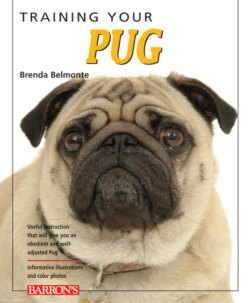Читать книгу Training Your Pug - Brenda Belmonte - Страница 19
На сайте Литреса книга снята с продажи.
Socialization
ОглавлениеThere are two important goals to shoot for when purchasing a Pug puppy. The first is to purchase a puppy that has the best chance to live a normal life, free from disease and hereditary conditions. The second is to select a puppy with a stable, social temperament. A properly socialized Pug puppy has the temperament to tackle any “job” he is given. Whether he is to spend his life as a beloved family pet, perform in obedience or agility competitions, or provide affection to others as a therapy dog, he must have the confidence to interact with people and be comfortable in locations outside of his own home.
How a puppy is treated before he joins your family directly influences your puppy’s ability to learn. Critical periods of development occur at specific ages in a puppy’s life. If a puppy is too stressed during these sensitive periods, it can negatively influence his trainability for even the simplest tasks can be negatively influenced.
Pug puppies separated from littermates before eight weeks of age miss the opportunity to learn about interactions with other dogs. Social interactions with humans should begin as early as three to five weeks of age. By nine weeks of age, puppies form a distinct preference for the location of elimination (inside vs. outside) and for the surface they prefer to eliminate on (newspaper, grass, concrete, gravel). The exploration period, when puppies are comfortable learning about new places and objects, begins as early as ten weeks of age, and continues until a puppy reaches four to five months of age.
PUG POINTER
Obedience classes with a curriculum geared specifically toward puppies aged ten weeks to six months are offered by kennel clubs, boarding and training kennels, veterinary clinics, and local park districts. These classes, known as Puppy Kindergartens or Puppy Socialization, teach basic obedience commands while offering your Pug puppy a chance to play with other dogs of similar age.
Puppy classes are a terrific way to socialize your Pug properly after you bring it home. A well-run class provides a safe environment for your puppy to play in, and gives you an early way to begin training your Pug.
A properly run puppy class has a maximum of six to eight puppies per instructor and is located in a space that is large enough to accommodate safe play. The instructors should be knowledgeable about dog behavior, proper dog training techniques, and be able to communicate these in a clear manner. The curriculum should include instruction on how to handle common puppy problems, basic obedience commands, and should be taught in a positive manner.
Using these guidelines, you can begin to understand why some Pugs may be difficult to housebreak, anxious about new people or places, and appear to learn more slowly than others. Some Pug puppies may be slow to housebreak if they are only used to eliminating indoors, on newspapers, at twelve weeks of age. A Pug puppy with little contact with strangers before being sent to join his new home may always be apprehensive of new people. The Pug puppies offered through pet stores are usually separated from their littermates before eight weeks of age, which may make it difficult for them to properly interact with other dogs.
Positive new experiences need to continue after you bring your puppy home. Exposing your Pug to new people and places, and avoiding situations which may be too frightening or stressful, lays the foundation for your Pug puppy to accept new rules and succeed in becoming a well-trained Pug.
